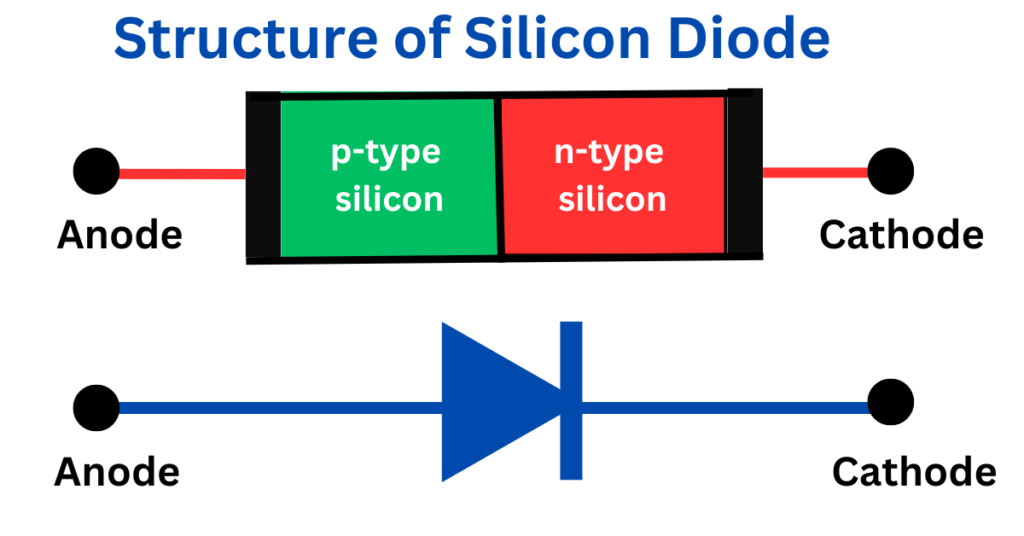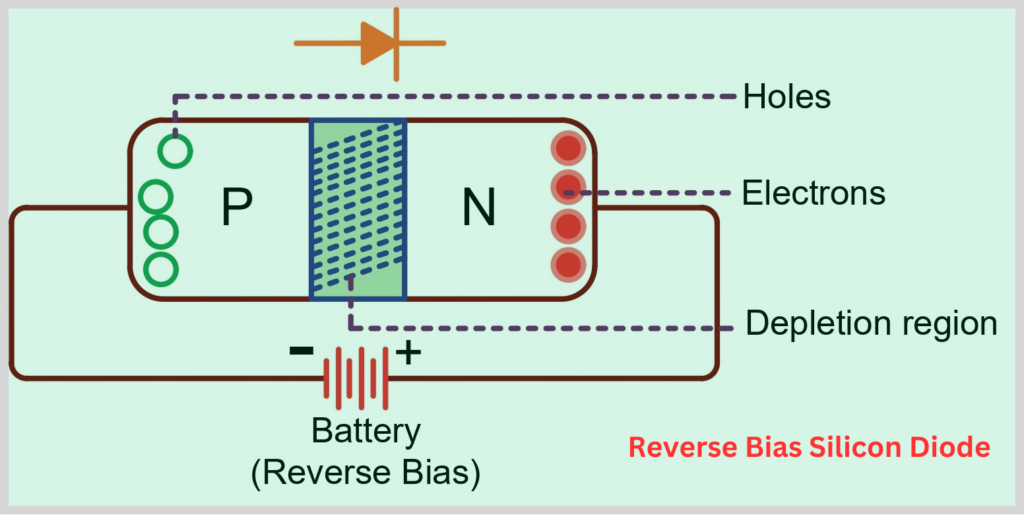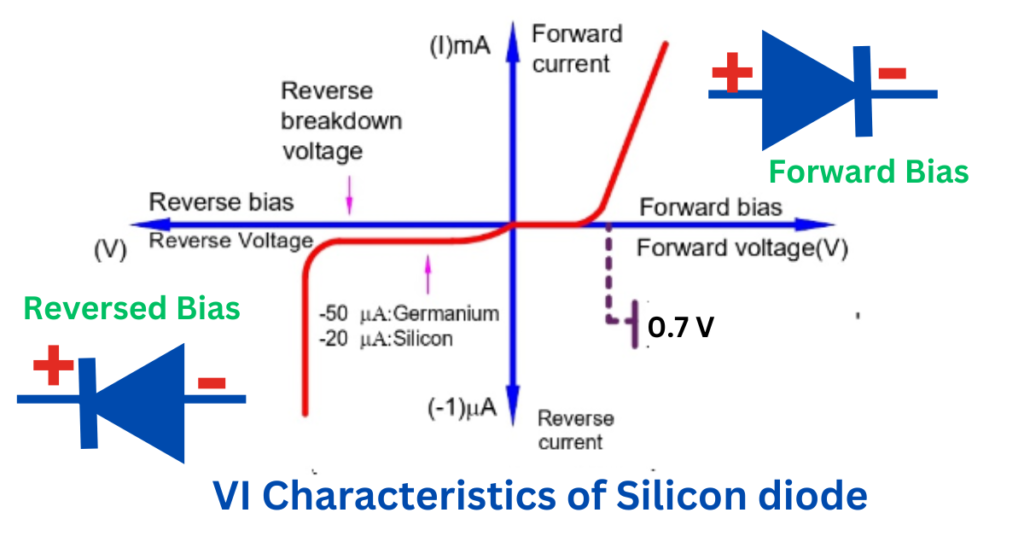A silicon diode is a type of power diode made using silicon semiconducting material. These diodes are commonly used in various applications such as motor control and drives, air conditioning PFC, general-purpose drives (GPD), industrial SMPS, AC/DC converters, boost diodes in PFC stages, general-purpose inverters, freewheeling functions, polarity protection, ultrasonic systems, welding, back-off diodes, and emergency generators.
What is a Silicon Diode?
A silicon diode is a semiconductor device that allows current to flow in one direction only, acting essentially as a one-way valve. It is made primarily from silicon, a material chosen for its stable and reliable semiconductor properties. The diode has two terminals: an anode and a cathode, where the anode is connected to the p-type semiconductor and the cathode to the n-type semiconductor.
Features of Silicon Diode
- Unidirectional Conductivity: One of the most fundamental features of silicon diodes is their ability to conduct current in only one direction. This characteristic allows them to function effectively as rectifiers, blocking current in the reverse direction while allowing it to pass when forward-biased.
- Low Forward Voltage Drop: Silicon diodes typically exhibit a forward voltage drop of approximately 0.6 to 0.7 volts when conducting current. This low voltage drop minimizes circuit energy loss, particularly in power conversion and signal processing applications.
- High Switching Speed: Silicon diodes can quickly switch from conducting to non-conducting states. This high switching speed benefits digital circuits and high-frequency applications where rapid response times are necessary.
- Thermal Stability: Silicon diodes offer good thermal stability, meaning they can operate effectively over a wide range of temperatures. This stability is important for applications that may experience fluctuating or extreme thermal conditions.
- Reliability and Durability: Silicon, a semiconductor material, is known for its durability and reliability. Silicon diodes are resistant to wear and degradation over time, making them suitable for long-term applications in various industrial and commercial settings.
- Reverse Breakdown Voltage: While silicon diodes are designed to block current in the reverse direction, they can withstand a certain reverse voltage up to a point known as the reverse breakdown voltage. This property is especially useful in designing protective circuits, such as voltage regulators and surge protectors, where controlled breakdown can safeguard other components.
Structure of Silicon Diode

A silicon diode comprises p-type and n-type semiconductor materials fused to create a pn junction. The p-type material is impure and has positively charged holes, while the n-type material has negatively charged electrons. When the two materials are combined to form a pn junction, the free electrons from the n-type material move across the junction to fill the holes in the p-type material. This movement of electrons creates a depletion region close to the junction with no free carriers, i.e., electrons or holes.
Working of a Silicon Diode
The operation of a silicon diode across different biasing conditions—no bias, forward bias, and reverse bias—demonstrates its essential role as a rectifier in electronic circuits. Here’s how a silicon diode works under each of these conditions:
No Bias
When no external voltage is applied to a silicon diode, it remains in an equilibrium state. The diode does not conduct electricity in this condition because the intrinsic electric field within the depletion region at the p-n junction prevents any significant current flow. The depletion region, created by the junction between the p-type and n-type semiconductors, acts as a barrier that prevents electrons and holes from moving freely across the junction.
Forward Bias
In forward bias, the positive terminal of the power source is connected to the anode (p-type semiconductor) and the negative terminal to the cathode (n-type semiconductor). This setup reduces the width of the depletion zone by pushing the holes in the p-type region toward the junction and the electrons in the n-type region toward the junction as well. As the barrier (depletion region) narrows, it allows charge carriers to cross the junction more easily.

When the external voltage applied across the diode exceeds the built-in potential of the diode (typically about 0.6 to 0.7 volts for silicon diodes), the diode becomes conductive, allowing significant current to flow through the circuit. This flow happens because the external voltage neutralizes the internal electric field forming the barrier in the depletion region, allowing carriers to recombine on crossing the junction and thereby conduct electric current.
Reverse Bias
Conversely, when the diode is reverse-biased (positive terminal connected to the cathode and negative to the anode), the external voltage enhances the internal electric field, increasing the width of the depletion zone. This widening of the barrier strengthens the blockade against charge carriers. In this state, the diode prevents current flow, with only a negligible leakage current (reverse saturation current) due to the thermal generation of electron-hole pairs within the semiconductor material.

As the reverse voltage increases, the diode remains non-conductive up to a critical voltage known as the breakdown voltage. Beyond this voltage, the diode’s structure starts to allow a sudden increase in current, typically due to avalanche or Zener breakdown, depending on the construction and doping levels of the diode. This characteristic is used strategically in applications like voltage regulation and surge protection.
VI Characteristics of Silicon Diode
The Voltage-Current (VI) characteristics of a silicon diode provide a graphical representation of the behavior of the diode under different voltage conditions in both forward and reverse bias. The operation of a Silicon diode can be explained through its V-I characteristic curve, as depicted below:

Forward Bias VI Characteristics
- Threshold Voltage: Initially, when a small forward voltage is applied, the diode does not conduct, and the current through it is negligible. This is because the applied voltage is less than the diode’s threshold voltage (also known as the cut-in voltage), typically around 0.6 to 0.7 volts for silicon diodes.
- Conduction Onset: As the applied voltage reaches this threshold voltage, the diode starts to conduct current. The current increases gradually at first due to the exponential relationship between the current and the voltage across the diode as described by the diode equation:
 where 𝐼 is the current through the diode, 𝐼0 is the reverse saturation current, V is the voltage across the diode, VT is the thermal voltage (approximately 26 mV at room temperature), and n is the ideality factor, typically close to 1 for silicon diodes.
where 𝐼 is the current through the diode, 𝐼0 is the reverse saturation current, V is the voltage across the diode, VT is the thermal voltage (approximately 26 mV at room temperature), and n is the ideality factor, typically close to 1 for silicon diodes. - Exponential Growth: After surpassing the threshold, the current through the diode increases exponentially with further small increases in voltage. This part of the curve is very steep, indicating that the diode allows a large increase in current for a relatively small increase in voltage.
Reverse Bias VI Characteristics
- Leakage Current: When reverse-biased, the diode shows a very different behavior. Initially, only a tiny leakage current flows, termed the reverse saturation current, typically in the nanoampere or microampere range. This current flow is due to minority charge carriers and is very small, often negligible.
- High Resistance: In this state, the diode behaves almost like an open circuit, with the current being nearly independent of the applied reverse voltage. The diode shows high resistance to the reverse current flow.
- Breakdown Region: As the reverse voltage is increased to a high value, the diode eventually reaches its breakdown voltage. Beyond this voltage, the diode starts to conduct current rapidly in the reverse direction. This is not due to the normal operation of the diode but rather due to breakdown mechanisms like avalanche or Zener breakdown, depending on the type of diode. The breakdown voltage can vary widely based on the diode’s design and intended use.
Applications of Silicon Diode
Silicon diodes are versatile and critical components in many electronic applications due to their reliability, efficiency, and the distinct characteristics of silicon as a semiconductor. Here are several key applications of silicon diodes:
1. Rectification: Silicon diodes are extensively used in rectifiers, which convert alternating current (AC) to direct current (DC). They are vital in power supplies for consumer electronics, computers, and industrial equipment, where they ensure that electricity flows in a single direction, thereby converting the input AC into usable DC output.
2. Voltage Clamping: Diodes can protect circuits by clamping voltage to a safe level in case of voltage spikes. For instance, during an unwanted voltage surge, diodes can redirect the excess voltage away from sensitive components, thus preventing damage.
3. Signal Demodulation: Diodes are used to demodulate amplitude-modulated (AM) signals in communication systems. The diode rectifies the AM signal, allowing the extraction of audio or other information signals from the carrier wave.
4. Power Conversion: In addition to rectification, diodes are used in various types of power converters, including inverters, which convert DC back to AC, and voltage multipliers, which increase voltage levels for specific applications like in cathode ray tubes and photomultiplier tubes.
5. Voltage Regulation: Zener diodes, a special type of silicon diode, are used for voltage regulation. They allow current to flow in reverse bias when a specified reverse voltage is reached, maintaining a constant voltage over a wide range of load conditions. This feature is crucial for providing stable power to sensitive electronic components.
6. Switching Circuits: Silicon diodes are used in digital and pulse circuits for their fast switching characteristics. They are essential in applications that require rapid transitions between high and low states, such as clock and timing circuits.
7. Temperature Sensing and Compensation: Diodes can be used in temperature sensors and temperature-compensated circuits. The forward voltage drop across a diode changes with temperature, which can be measured and used to infer the temperature or compensate for temperature variations in a circuit.
8. Solar Panels: In solar power systems, diodes are used as bypass diodes connected across solar cells to protect them from thermal damage in case some cells are shaded while others are exposed to sunlight. They prevent the reverse current that can heat and damage the shaded cells.
9. Protection in Automotive Applications: Diodes are used in automotive electrical systems to allow current to flow only in the desired direction, protecting sensitive electronics from damage due to reverse polarity connections.
How To Test Silicon Diodes
Testing diodes is relatively simple since they are basic electronic components with only two terminals. An adjustable DC power supply, a multimeter, and a known load resistor are required to confirm their fundamental operating properties and parameters. By using these tools, one can get an accurate assessment of the diode’s healthiness.
- Ensure that the forward voltage drop of the silicon diodes matches the specifications, which should be around 0.7V.
- Verify whether the diode is blocking the current in reverse bias up to the expected breakdown voltage or not.
- Connect a load and measure the reverse recovery time in nanoseconds to perform the test.
- Graph the current vs. voltage to show the diode response.
If any silicon diode fails to meet the benchmark performance standards, it must be replaced.
Conclusion
Silicon diodes are indispensable in electronics, serving a variety of functions, from power conversion to protection and signal processing. Their efficiency, reliability, and quick response make them ideal for digital and analog applications across various industries, including telecommunications, automotive, and consumer electronics. Understanding their properties and operation helps in effectively incorporating these components into electronic designs to enhance functionality and reliability.